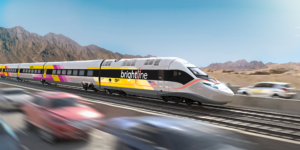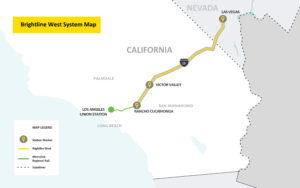CHSRA Taps SYSTRA | TYPSA JV to Design Track, OCS for Initial Passenger Service (UPDATED)
Written by Carolina Worrell, Senior Editor, Railway Age
BURBANK, Calif. – The California High-Speed Rail Authority’s (CHSRA) Board of Directors on June 26 approved the joint venture of SYSTRA | TYPSA to begin designing track and overhead contact systems (OCS) for the initial 171-mile passenger service connecting Merced to Bakersfield.
The JV, CHSRA says, has worked together for more than two decades and partnered with California rail and transit agencies for more than 35 years.
With an initial contract value of up to $131.2 million, this contract will allow the CHSRA to:
- “Produce high-level designs for track and OCS for the 171 miles connecting Merced to Bakersfield, including detailed designs for the 119-mile section currently under active construction within that Central Valley stretch.
- “Design the track system, including the track structure, OCS, along-track cable containment, across-track ducts, access walkways, fencing, and drainage.
- “Manage technical and non-technical interfaces with contractors/consultants.”
“Getting track and systems design under contract is an important milestone in movement to bring high-speed rail service to California,” said CHSRA Board Chair Tom Richards. “This approval gets us closer to electrified passenger rail service and putting this transformative project into operations as soon as possible.”
In October 2022, CHSRA opted to let a previous Request for Qualifications (RFQ) for procurement of a track and systems contractor expire due to the economic climate, supply-chain challenges and 40-year high inflation.
CHSRA has since developed a new procurement strategy, “considering extensive industry feedback and adjusting to program needs.” “The track and OCS design services contract is an important step in the new procurement strategy,” CHSRA noted. This contractor will collaborate with a future construction manager/general contractor hired to construct the track and OCS based on its designs.
Since the start of construction, CHSRA says it has created more than 13,500 construction jobs, a majority going to residents from the Central Valley.
CHSRA has begun work to extend the 119 miles currently under construction to 171 miles of future electrified high-speed rail from Merced to Bakersfield. There are currently more than 25 active construction sites in the Central Valley, with the CHSRA having now fully environmentally cleared 422 miles of the high-speed rail program from the Bay Area to Los Angeles County.
In related news, CHSRA announced June 26 that the Flint Avenue overcrossing is now open to traffic in Kings County.

Located north of the city of Hanford and designed and constructed by Dragados-Flatiron Joint Venture (DFJV) to take traffic over the future high-speed rail tracks, the Flint Avenue overcrossing, which is 205 feet long and more than 40 feet wide, is the latest high-speed rail structure to be completed and opened to traffic in the Central Valley, according to CHSRA.

The Flint Avenue overcrossing also includes 663 cubic yards of concrete and 215,720 pounds of steel. Fifteen pre-case concrete girders were all manufactured at the DFJV Pre-Cast Girder Facility in Hanford.
Also, in related news, CHSRA’s Board of Directors on June 27 approved the final environmental document for the 38-mile segment between Palmdale and Burbank. The approval of the Final Environmental Impact Report/Environmental Impact Statement (EIR/EIS) is the last environmental clearance between downtown San Francisco and downtown Los Angeles. CHSRA on May 24 first released the final environmental documentation.

At speeds up to 220 mph, this section, CHSRA says, will connect the Antelope Valley to the San Fernando Valley in a roughly 17-minute train trip–more than twice as fast as traveling by car.
“This is a transformative project for the state of California as a whole, and today’s approval is a major milestone for connecting San Francisco to Los Angeles in less than three hours. It’s also transformational for Los Angeles County, connecting Palmdale to Burbank in a way that’s never been possible before,” said CHSRA CEO Brian Kelly.
The Board’s actions move this section closer to being “shovel-ready” as funding becomes available, marking the third certification of an environmental document in the Southern California region and the second in the Los Angeles Basin since 2022, according to CHSRA.
“Today’s approval is more than a historic milestone–it closes the gap between Los Angeles and San Francisco,” said Richards. “We value our Authority team and its tireless support and collaboration with local and regional agencies and stakeholders as we work together to improve transportation in California for future generations.”
According to CHSRA, the Palmdale to Burbank Project Section will connect two key population centers in Los Angeles County by linking future multimodal transportation hubs in Palmdale and Burbank. The section features about 30 miles of tunneling, including 28 miles through mountains.
The Board approved the SR14A Alternative, which runs partly along State Route 14 and is approximately 38 miles long. It will be a grade-separated, high-speed rail-only system. Trains will be underground through the community of Acton and much of the Angeles National Forest and the San Gabriel Mountains National Monument.
The approved alignment, CHSRA says, “reduces the length of tunneling that would traverse the Angeles National Forest and San Gabriel Mountains when compared to other alternatives. Tunneling through these regions minimizes impacts to communities and environmental resources in the region.”
CHSRA serves as the lead agency under the California Environmental Quality Act (CEQA) and the National Environmental Policy Act (NEPA). The Draft EIR/EIS was circulated for public review and comment from early September through early December 2022.
All that remains to environmentally clear the full 494-mile Phase 1 system of the project is the Los Angeles to Anaheim segment, which CHSRA expects to finalize next year.





